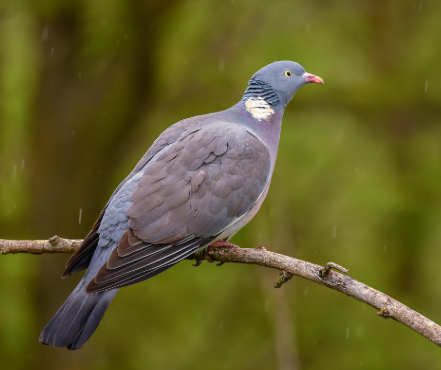The wood pigeon (Columba palumbus) is a large, common species of pigeon found across Europe, western Asia, and North Africa. Here’s a detailed description:
Physical Appearance:
- Size: The wood pigeon is one of the largest pigeons, measuring 38–43 cm (15–17 in) in length with a wingspan of 68–80 cm (27–31 in).
- Weight: Typically weighs between 300 and 615 grams (10.6–21.7 oz).
- Coloration:
- The body is mostly pale grey.
- The head and neck have a purplish or greenish iridescence.
- A distinctive white patch on the sides of the neck is particularly noticeable, giving it a “collared” appearance.
- The chest is pinkish with shades of mauve.
- Wing feathers feature broad white bars, creating a striking appearance in flight.
- Tail feathers are dark grey with a black band at the end.

Behavior:
- Flight: Characterized by strong and deliberate wingbeats. Their flight often includes sudden glides with wings held stiffly.
- Call: A cooing sound described as “coo-COO-coo…coo-coo.”
- Diet: Omnivorous, feeding mainly on seeds, grains, fruits, and occasionally buds and young shoots. They may forage on the ground or in trees.
- Breeding: Builds a flimsy platform nest of twigs in trees or shrubs. Typically lays two white eggs, which are incubated by both parents.
Habitat:
Wood pigeons are highly adaptable, found in woodlands, farmland, gardens, and urban parks. They thrive in both rural and urban settings, showing a preference for areas with ample food and tree cover.
Behavior and Social Structure:
Wood pigeons are often seen in pairs during the breeding season but form large flocks outside of it, especially when food sources are abundant. They are known for their wary nature, quickly taking flight at the first sign of danger.
Conservation Status:
The wood pigeon is not considered threatened and has a stable population. It is common in many parts of its range and has adapted well to human-altered landscapes.
This pigeon is both admired for its graceful flight and recognized as a pest in some areas due to its feeding habits on crops.

Leave a Reply
You must be logged in to post a comment.